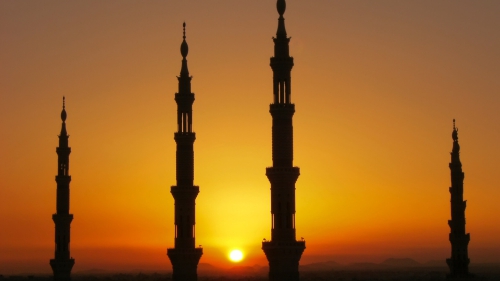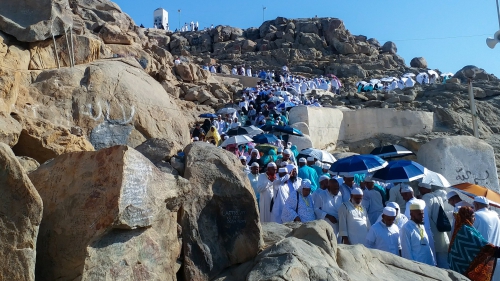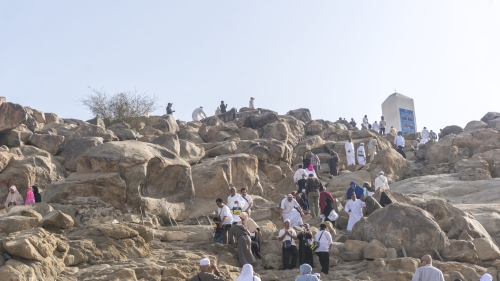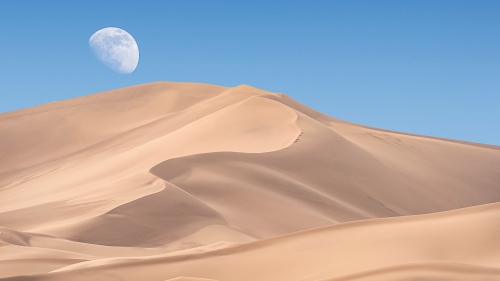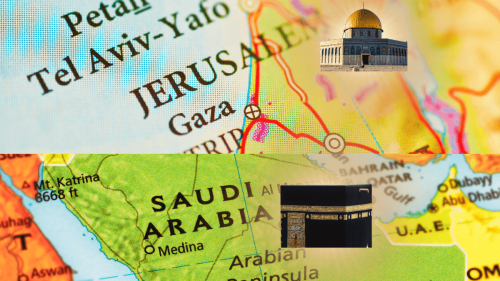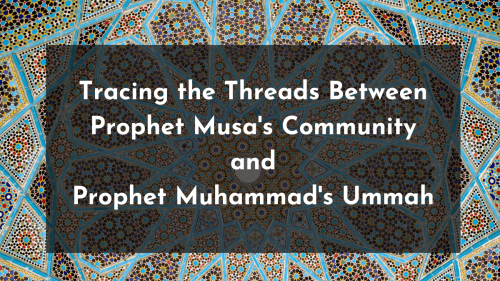Isra and Mi’raj (Part One)
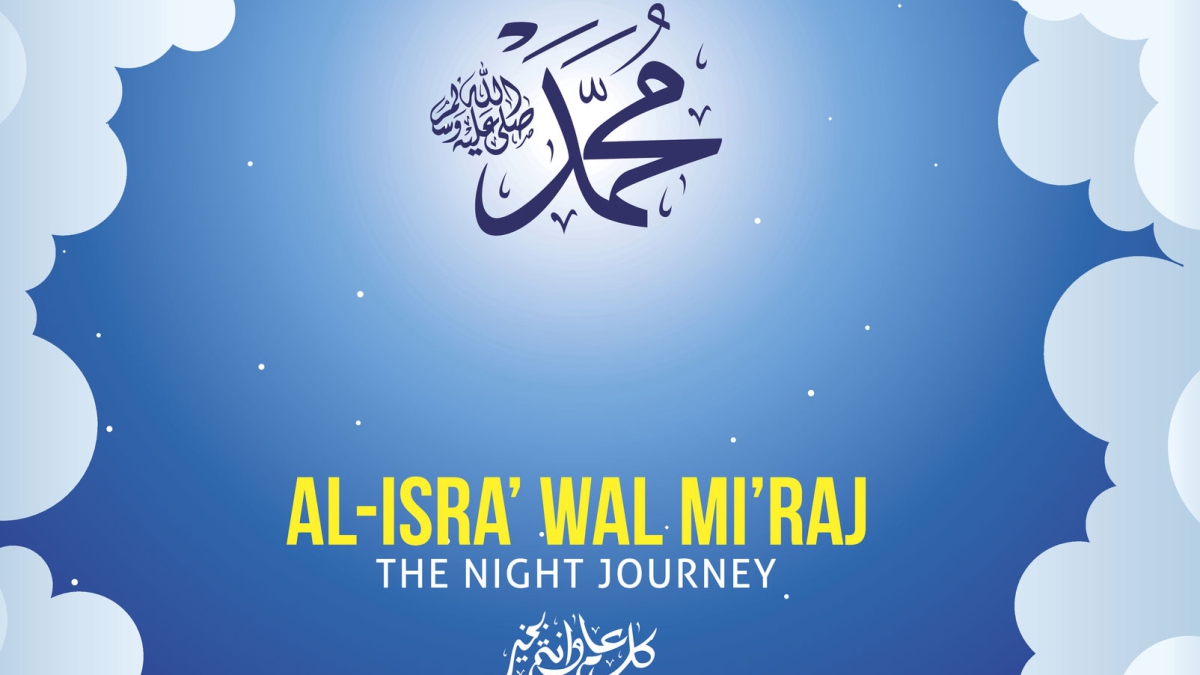
The event Isra and Mi’raj is divided into two parts. The first part is related to Prophet’s (PBUH) journey form Makkah to Bait-al Muqaddas (بیت المقدس) in Jerusalem, and the second part is related Prophet’s (PBUH) journey to the heavens to meet with Allah.
As far as the first part is concerned, the verse (17:1) of Surah Bani Israel is presented in its support:
سُبْحَانَ الَّذِي أَسْرَىٰ بِعَبْدِهِ لَيْلًا مِّنَ الْمَسْجِدِ الْحَرَامِ إِلَى الْمَسْجِدِ الْأَقْصَى
(17:1) – Glory to (Allah) Who did take His servant for a Journey by night from Al-Masjid-al-Haram in Makkah to Masjid Al-Aqsa in Jerusalem.
Our history and hadith books have given very detailed explanation of the event. All our past Imams and scholars have written about it and given considerable details about this event such as:
“This was the 12th year of Messenger-hood and the Prophet (PBUH) was sleeping in the courtyard of the Masjid Al-Haram. Then suddenly the angel Gabriel woke him up and took him to Zamzam-well and opened his chest and cleansed its inside with Zamzam water; and filled it with knowledge, mercy, wisdom, faith, and resolve. After this, a white animal was presented to him for journey which was little smaller than a mule. It was called Buraq since it traveled as fast as lightning. Previous Prophets also used to travel on this animal. The Prophet (PBUH) rode on it but it chuckled a little. Then Gabriel patted it gently and told that no greater man than Muhammad (PBUH) has ever ridden you. Then it became quiet, and Muhammad (PBUH) and Gabriel rode on it. Its first stop was Medina where the Prophet (PBUH) performed his prayer. Gabriel told the Prophet (PBUH) that you will come here after Hijrah. The next stop was Mount Sinai where God spoke to Moses (PBUH). Then the next stop was Bethlehem where Jesus (PBUH) was born. The final stop was Bait-al Muqaddas (بیت المقدس) in Jerusalem. The Prophet (PBUH) tied the Buraq where previous Prophets used to tie it. Then the Prophet (PBUH) entered Solomon’s temple and saw that all the previous Prophets – who had come since the beginning – were already gathered together there. They all lined up for prayer and were waiting to see who will lead the prayer. Then Gabriel gently nudged the Prophet (PBUH) to lead the prayer. After the prayer Gabriel presented three cups – one had water, the second had milk, and the third one contained wine – to the Prophet (PBUH). The Prophet (PBUH) picked the one that contained milk. At this Gabriel thanked the Prophet (PBUH) and said that you have found path of Nature. After this a ladder was presented to the Prophet (PBUH), and Gabriel took him to the heavens through the ladder.” [Maududi, Tarjumanul Quran, August 1951]
In Arabic, ladder is called Mi’raj and hence the name of this event.
It is mentioned above that the Prophet (PBUH) led payer in Solomon’s temple in Bait-al Muqaddas (بیت المقدس). We also know the now familiar narrative from the Jewish people that Muslims demolished our Solomon temple and built their Masjid al-Aqsa on it. Therefore, Muslims do not have any right to claim this place as their own; that it has always been ours since David and Solomon. In response to this Jewish claim Maulana Maududi wrote:
“It is proven from historical records that Byzantines demolished the Solomon temple in the year 70 A.D. The complete destruction happened to Jewish people at the hands of the Byzantines in this year when they destroyed all their religious sites and drove the entire Jewish population out of Jerusalem. The Solomon temple was turned into a pile of rubles. Jerusalem became the center of Christianity under Byzantines. All this happened in first century, in 70 A.D. And Prophet Muhammad (PBUH) was born in sixth century A.D.” [Maududi, Tarjumanul Quran, September 1969]
Khalifa Umar’s (R) trip to Jerusalem
Byzantines had built their Cathedral in Jerusalem. Historical evidence suggests that Jerusalem was conquered by Muslims during Khalifa Umar’s (R) time. The Patriarch of Jerusalem insisted that the Khalifa himself must come to Jerusalem – only then he will sign the surrender treaty to Muslims. So, Khalifa Umar (R) went there. The details of his trip is well documented in recorded history.
During the treaty negotiations when the prayer time came and Khalifa Umar (R) wanted to pray, the Patriarch offered to arrange his prayer in the Cathedral itself. At this Khalifa Umar (R) said that he does not want to pray in the Cathedral because later generations might demolish it and build a mosque there; that he does not want to set such a precedence.
So, Khalifa Umar (R) started looking for a place to pray outside of the Cathedral’s precincts. But the outside precincts were not only full of rubles but were covered with garbage as well. So, he started collecting that garbage and throwing it away. Please imagine this scene! The head of the greatest Islamic nation, the Amir-ul-Momineen, who came to Jerusalem as victor, and here he was personally clearing the garbage thrown by Christians on Jewish sacred site! How magnanimous Khalifa Umar (R) was? Then he found an elevated stone (Qubba) and he offered his prayer there.
The gist of the treaty signed by Khalifa Umar (R) was that there will be complete freedom of religion for all; that all religious sites will be sacrosanct and will be respected; and that Muslims will have the duty to protect these religious sites because the entire holy land was now under their control.
After the treaty was concluded, Muslims built a small mosque as a symbol of respect for the place where Khalifa Umar (R) had prayed. But later, during the Umayyad period (661-750 A.D.), Abdul Malik bin Marwan built a dome on the rock where Khalifa Umar (R) had prayed, and named it Masjid Al-Aqsa because it was the farthest mosque at the time. This is how Masjid Al-Aqsa came into being. The name Masjid Al-Aqsa was written on a stone slab and below it was written the year 72 Hijrah, which visitors could see it. The Jewish claim that Muslims built this mosque where their temple was, is wrong because the Byzantines had demolished it in year 70 A.D. and there was nothing except rubles and garbage. The Byzantines even prevented Jewish people from visiting the holy land.
It is the Muslims who opened the holy land to Jewish people. Muslims told them that they are welcome to visit their sacred sites even though the Byzantines had destroyed them. Though the temple was destroyed by the Byzantines, there was a small wall that was part of the temple where Jewish people started praying and crying at the loss of their temple – and, thus, this wall came to be known as the “wailing wall.”
Therefore, Masjid Al-Aqsa in the Quranic verse (17:1) cannot refer to Masjid Al-Aqsa in Jerusalem because there was nothing except rubles there, let alone there being a mosque. The Masjid Al-Aqsa in Jerusalem was built, as noted above, in 72 Hijrah by Abdul Malik bin Marwan. All historians agree that Byzantines had destroyed Jerusalem and the Solomon temple in 70 A.D. and built their own Cathedral there. Even during Khalifa Umar’s (R) time there was no Masjid Al-Aqsa and there was no Solomon temple in Jerusalem. So, how could Masjid Al-Aqsa and Solomon temple be there during Prophet’s time?
Masjid Al-Aqsa in verse (17:1) refers to Medina
The atmosphere in Makkah had become unbearable for the Prophet (PBUH) and his companions, and there was little hope that the message of Islam would be accepted by those who had not only rejected it but planned to kill the Messenger (PBUH). So, Allah in His limitless glory carried his devotee by night from the sacred mosque of Makkah to the farthest mosque in Medina – where the atmosphere was much more conducive, and its environs Allah had blessed. The purpose of the migration was that the promises made by Allah to the Prophet (PBUH) in Makkah be fulfilled in Medina. Most certainly Allah never breaks His promise (2:80). Allah’s decisions are based on Knowledge and Wisdom (17:1). History bears testimony that all the promises made by Allah to the Prophet (PBUH) were fulfilled in Medina.
Allah would show His greatest signs to the Prophet (PBUH), as He had shown to His previous messengers, especially Moses (PBUH):
لِنُرِيَكَ مِنْ آيَاتِنَا الْكُبْرَى
(20:23) – So We would show thee some of Our greatest signs.
Migration is not a new phenomenon. It was part of the program of all messengers. It especially played a prominent part in the case of Moses (PBUH). Moses (PBUH) was given the book of guidance (23:49) to guide Israelites out of the depth of darkness of slavery to the shining light of freedom and sovereignty. And the world saw the rule and sovereignty of Solomon (PBUH) and David (PBUH) for thousands of years which Allah has called as His signs. The same way Allah was going to show His signs to the Prophet (PBUH) (17:1) by establishing His rule and sovereignty in Medina.
Aqsa means far away and Medina in those days was considered to be far away from Makkah. When the Prophet (PBUH) started his divine call in Makkah, many people of Medina (who used to visit Makkah for pilgrimage) accepted Islam and built Masjid in Medina to offer prayers; and used it for consultation and discussion about Islam.
Also, the word سُبْحَانَ (Subhan) signifies that some major extraordinary powerful event is going to happen. And the Authority whom it refers to is the Almighty Allah who has all the power and control to make it happen through His Messenger. It signifies that the mission of the Prophet (PBUH) will take a quantum leap towards its goal. The Quraysh had made the life of the Prophet (PBUH) unbearable; they were making all sorts of accusations against him; they were calling him crazy; they were putting roadblocks in his path; they were torturing his followers; they stoned him (PBUH) in Taif; they went to the king of Abyssinia to complain against him etc. etc… Now things were going to change for him (PBUH) and his companions (R). Their struggle to establish the divine system was entering a new phase. The Prophet (PBUH) and his companions will acquire power in the land:
وَعَدَ اللَّـهُ الَّذِينَ آمَنُوا مِنكُمْ وَعَمِلُوا الصَّالِحَاتِ لَيَسْتَخْلِفَنَّهُمْ فِي الْأَرْضِ كَمَا اسْتَخْلَفَ الَّذِينَ مِن قَبْلِهِمْ
(24:55) – Allah has promised people who have faith in the truthfulness of the Divine Laws and who do the righteous deeds, that He will establish their authority on this earth. This is Our Eternal Law according to which We caused previous generations to establish their authority on this earth. According to this Law and as a result of their Iman and righteous deeds, We will grant them rule over the land and strengthen the system of life which We have chosen for them.
The word “Masjid” means the center from which Allah’s obedience is carried out
Please note that verse (17:1) mentions that the migration will happen from one Masjid to another Masjid. It is alright that Masjid is a place where prayer is offered. But it is not just a building that is called Masjid. In Islam, Masjid is the center from where Allah’s commands are carried out and officially implemented as demonstrated by the Prophet (PBUH) – from Masjid-Nabawi. Wherever a place may be, if Allah’s commands are carried out from that place then it is a Masjid even if a building may not be there. There is a shining hadith of the Prophet (PBUH) that says: the entire Earth is Masjid. Wherever Allah’s servants carry out His obedience it is a Masjid, whether or not there is an actual physical structure. So, the verse (17:1) says that Allah took his servant in the night from one Masjid (Kaaba) to another Masjid (Medina) where Allah will show his signs of grandeur which were hidden until then, but these signs will become manifest now. The reality will reveal itself and will become manifest there. And, history bears testimony that these powerful signs of magnificence and grandeur did become manifest in Medina.
In the light of the above explanations the meaning of this verse is clear: that Allah, the possessor of Infinite Might, helped the Prophet (PBUH) to migrate by night from Makkah – where he and his companions were being persecuted and subjugated – to the far away land (Medina) which was to become the center of divine order; so that the Prophet (PBUH) and his companions could establish the divine system of universal sustenance, and expand it – by knocking out all barriers in its path. And history proves that Prophet (PBUH) and his companions did succeed in establishing the divine system and it did change the world significantly despite the continued opposition and attacks from the enemies.
Under this hostile and challenging situation, creating a Quranic State in Medina by the Prophet (PBUH) and his companions was no less than a miracle as acknowledged even by non-Muslim scholars (e.g., Lamartine - Histoire de la Turquie, Paris 1854, Vol. II, pp. 276-77).
إِنَّ اللَّـهَ وَمَلَائِكَتَهُ يُصَلُّونَ عَلَى النَّبِيِّ ۚ يَا أَيُّهَا الَّذِينَ آمَنُوا صَلُّوا عَلَيْهِ وَسَلِّمُوا تَسْلِيمًا
(33:56) – Verily, God and His angels bless the Prophet: [hence,] O you who have attained to faith, bless him and give yourselves up [to his guidance] in utter self-surrender!
Topics: Jerusalem, Masjid Al Aqsa, Night Journey (Isra And Miraj), Prophet Muhammad (S), Umar Ibn Al Khattab
Views: 5871
Related Suggestions







